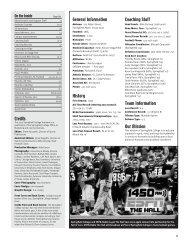CLIMBING WALL OPERATIONS MANUAL
CLIMBING WALL OPERATIONS MANUAL
CLIMBING WALL OPERATIONS MANUAL
You also want an ePaper? Increase the reach of your titles
YUMPU automatically turns print PDFs into web optimized ePapers that Google loves.
SPRINGFIELD COLLEGE <strong>CLIMBING</strong> <strong>WALL</strong> <strong>OPERATIONS</strong> <strong>MANUAL</strong><br />
7. Clip both the wire cable on the ATC and the bight of rope into the locking carabineer, and screw<br />
the gate of the carabineer shut.<br />
8. Clip a second carabineer into your harness at the waist and groin loops on the side opposite your<br />
braking hand. Clip this carabineer into one of the pretied loops on the anchor ropes attached to the<br />
floor at a point which offers the least slack in the anchor rope. This prevents the belayer (you)<br />
from being pulled off the floor in the event the climber takes a fall (or if the climber weighs more<br />
than you do).<br />
8 Final Check Before Climbing<br />
Once both climber and belayer are tied in so set up, stop and both partners should check the setup. Make<br />
sure of the following:<br />
a. All harness buckles are doubled back.<br />
b. All knots are properly tied and dressed.<br />
c. All carabineers are properly aligned, and screwed shut.<br />
9. How to Belay<br />
Belaying itself is relatively simple provided one is always paying attention to your climbing partner. The<br />
end of the rope which passes through the toprope anchor and goes back down to the climber is called the<br />
"live" end of the rope. The "live" end is handled by the "guide" hand. The other end of the rope is the<br />
"brake" end which is handled by the "brake" hand. You must always have at least one hand on the brake<br />
end of the rope at all times. If you don't, and the climber begins to fall, you will not be able to regain<br />
control of the rope, and the climber may be injured. As the climber proceeds up the wall, it is the belayer's<br />
job to take up the rope and make sure there is no slack in the system. This limits the distance the climber<br />
can fall. Make sure both hands never leave the rope!<br />
Taking Rope In (as the climber ascends)<br />
1. With both hands firmly on the rope, the guide hand pulls the rope towards the ATC as the brake<br />
hand pulls rope out and away from the ATC (Figure 1).<br />
2. When the guide hand reaches the ATC, hold the rope fast with the brake hand, while sliding the<br />
guide hand up the live end of the rope until it is above the brake hand (Figure 2).<br />
3. The guide hand now grasps both ends of the rope and pinches both off with the thumb while the<br />
brake hand slides back down the rope to the ATC. The hands are now back in position to repeat<br />
step 1 (Figure 3). The brake hand never leaves the rope!<br />
Updated 8/08 polices are subject to change without warning Page 11





